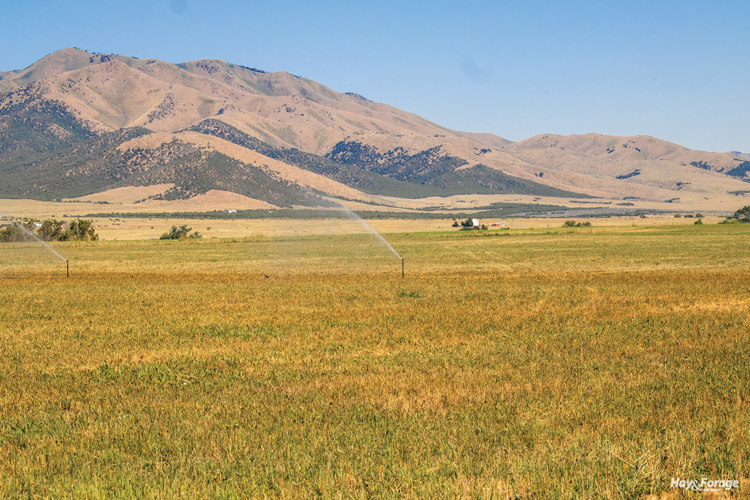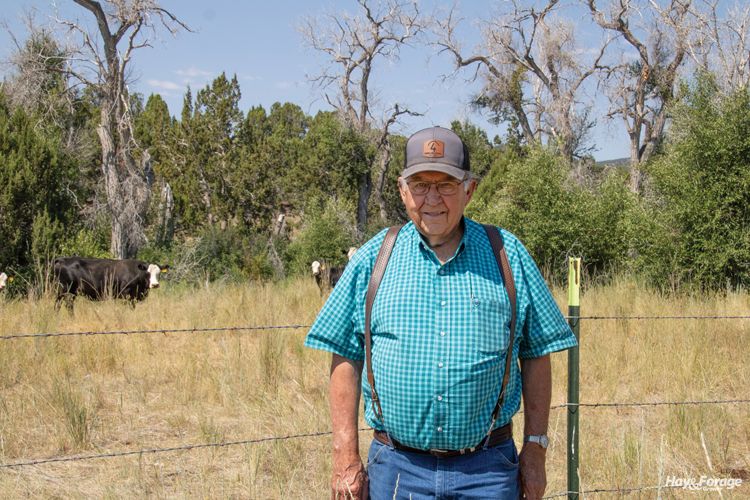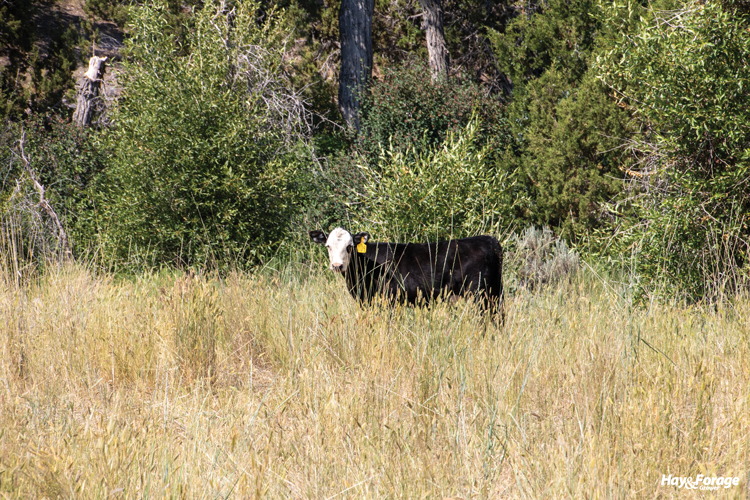
Twenty minutes from everywhere. That’s what Carol Johnson said it felt like living in the-middle-of-nowhere Rush Valley, Utah.
The city girl turned cattlewoman took farm life by the horns when she married Darrell Johnson in 1983. She championed her husband’s cattle operation situated around the small mountain town just south of the Great Salt Lake, and she supported his innovative efforts to eradicate invasive species on the dry rangeland of the Beehive State. Carol was eager to tell anyone and everyone about ranch life and raising cattle, including friends, neighbors, and the cashier at the grocery store 20 minutes down the road.
Darrell is the fifth generation of the Johnson family to ranch in Rush Valley after his great-great-grandfather was the first permanent settler there in 1856. Since then, Darrell, his father, and now his sons, Ed and Brian, have expanded the original 10-acre homestead to a grazing system that encompasses nearly 7,000 acres within a 10-mile radius — most of which are privately owned.
Owning such a large percentage of private land is a rare occurrence in the West, as most ranchers predominately graze public land with permits from the Bureau of Land Management (BLM). Nonetheless, the Johnsons have leveraged their extensive land ownership to convert encroaching juniper and sagebrush into permanent pastures of productive grass.
“My dad always used to say he didn’t know why his great-grandfather didn’t keep going or stop sooner,” Darrell joked about the fickle environment. “But it’s been good to us, this valley.”
Likewise, the Johnson family has been good to the valley. Darrell has collaborated with range specialists and researchers over the years to administer prescribed burns and improve his forage management. Because of his efforts to bolster a better use of the challenged land base, the affable 82-year-old has also been recognized as a regional winner of the National Cattlemen’s Beef Association’s Environmental Stewardship Award and with the Leopold Conservation Award from the Sand County Foundation.
But perhaps Carol was the biggest cheerleader and greatest advocate for the experimental solutions at Johnson Ranch before she passed away in 2022. It’s her memory and eternal admiration of the operation that Darrell reflects on as he looks forward to the family’s sixth and seventh generations carrying on the ranching legacy in Rush Valley.
Resolving to reseed
Johnson Ranch is classified as a juniper forest. The evergreen tree that is commonly found on dry plains has an ever-growing geographical range. What’s more is juniper is equipped with a vigorous root system and a bad reputation for choking out desirable forage. Despite its role as a feed source and wildlife habitat in many ecosystems, sagebrush has also become a problem species across Johnson Ranch and throughout the Intermountain West, especially at lower elevations.
Rather than work around these infringing shrubs and trees, Darrell decided to work against them. He started renovating rangeland to crested wheatgrass when he acquired land as a young rancher in the 1970s. By prescribing burns and chain-pulling juniper and sagebrush out of the ground, he prepared seedbeds and established crested wheatgrass with an aerial seeder.
Allen Rasmussen is a retired extension range specialist from Utah State University who helped conduct prescribed burns at Johnson Ranch, which, at the time, was a practice that had yet to be accepted in the area. Nonetheless, Darrell was eager to take a chance on the novel approach in effort to propel his grazing operation toward higher production.

“What makes Darrell unique is his willingness to try and do things most people wouldn’t do,” said Rasmussen, who later worked as a rangeland specialist at Texas A&M’s King Ranch in Kingsville, Texas. “We need people who are willing to step out and think about things differently like he has.”
Seeding the introduced species instead of a native grass also received speculation, but crested wheatgrass has proven to be a robust forage that not only outcompetes juniper, sagebrush, and cheatgrass, but is also a prolific feedstuff for cattle.
Rasmussen noted forage yield only averaged 50 pounds per acre in some areas at Johnson Ranch before burning and controlling invasive species. After crested wheatgrass was established, average yield per acre soared to more than 1,500 pounds.
“When you go from 50 pounds to over 1,500 pounds of forage, that is huge for your carrying capacity,” Rasmussen said. “Crested wheatgrass is very competitive for that environment. You can seed native grasses, and they can be good, but they are harder to manage and not as competitive.”
This competitive edge comes from the superb seedling vigor and excellent drought tolerance of crested wheatgrass, which is critical in the semi-arid climate that receives only 12 to 16 inches of rain per year. Rotating livestock through divided pastures has also seemed to enhance its stand persistence, earning it the colloquial title of “The Golden Grass of the West.”
“We’ve made a lot of improvements over the years, but the grass is the backbone,” Darrell affirmed.
In addition to its grazing merits, crested wheatgrass has alleviated compaction and erosion issues across Johnson Ranch. The fibrous root system of the perennial forage softened the soil structure of the dry, pavement-like dirt surrounding sagebrush and juniper. This ultimately regenerated the rangeland into a grass watershed, unlocking access to natural springs the moisture-hungry shrubs and trees had suppressed.
“When we changed to a grass watershed, it made a huge difference in the springs. We used to have two permanent springs, but now we have several that we have developed to run water into troughs,” Darrell said. “If you control the water — stock water and springs — then you control the grazing.”
Instead of hauling water to different fields or directing it down a pipeline from the top of the mountain, the Johnsons now use solar-powered pumps to carry spring water to troughs across their operation. Some water travels a total of 4 miles away and up 1,150 feet of rise from one spring to a stock tank in a distant pasture.
“We talk about the success of the grass in the pastures, but it’s also about being able to have a good supply of stock water,” said Brian, who returned to the ranch after moving east to work in the welding industry for a few years as a young adult. “It’s allowed us to use country where otherwise there is not a way we could have grazed it.”
Grazing for days
Crested wheatgrass greens up in early spring and stays productive into the fall. By padding either shoulder of the grazing season and having sufficient yield and quality throughout their rotation, the Johnsons have shortened their hay feeding to about 90 days a year.
“Nine months out of the year, the cows are used to a steady diet of crested wheatgrass,” Brian said. “It can be really green or really dry, but the cows adapt and do extremely well.”
The father-son trio adhere to a tight calving schedule in March and April. Then, the herd is turned out to crested wheatgrass pastures by early May.
“The crested wheatgrass is the secret to our calving success,” Brian asserted. “We get that spring moisture and the grass really turns on and greens up, so we can turn those cows out and get them bulled up.”
Getting bulled up — or rebred — is quicker and more effective when cows have access to abundant forage compared to sparser range that previously covered the landscape. From here, the Johnsons continue to move cows to higher elevations as the grazing season progresses, arriving at summer pastures seeded to intermediate varieties of crested wheatgrass that are better suited to the growing environment.
Their private acres don’t stretch as far up the mountain as some public leases do, and Brian admitted the higher ground has potential for better quality forage because of the elevation. However, grazing those acres comes at the cost of transportation. That’s one trade-off of owning private land the Johnsons are content with.

“A lot of guys will go up to higher elevations in the forest because it’s a lot better feed in the summer,” Brian said. “We just don’t have access to that, but we also don’t have to do the trucking. We basically open the gates and just move cows up the mountain.”
“The only time our cows get on a truck is when they go to town to be ground up for hamburger. We do everything on horseback around here,” Darrell chuckled.
The Johnsons typically forward contract calves through an auction in Snowbird, Utah, in mid-July, depending on the cattle market.
By the first of October, the herd returns home where the calves are weaned and delivered to buyers six weeks later. Meanwhile, cows continue to graze nearby pastures. Crested wheatgrass begins to dry out and turn brown, but the forage supports cows’ nutritional needs until the Johnsons start feeding hay in the winter.
A bright future
Despite some technological advancements at Johnson Ranch, the family still does old-fashioned farmwork by hand. Moving sprinkler pipes in irrigated hayfields, for example, is a necessary evil on the operation, but the Johnsons have learned to withstand water availability that fluctuates with snowpack levels in the Sierra Nevada Mountains. In dry years, they may come up short on homegrown hay and buy more bales than what was budgeted for. In wet years, it’s all hands on deck to move sprinkler pipes more frequently to take advantage of the abundant moisture.
Darrell was the captain of this irrigation crew well into his 70s before delegating the task to his grandchildren who live close by and some local kids who are eager to help. He is pleased to see that the responsibility and discipline required of ranching has shaped these youth into hard-working young men and women.
“They can drive, run the skid steer, and they know what it’s like to get up at six o’clock in the morning and move sprinkler pipe,” Darrell said. “We’ve certainly raised good kids on this ranch.”
In addition to raising their kids and running the ranch, Ed and Brian also work off the farm. The older brother is a vocational ag teacher while the younger is an engineer — both jobs are about 20 minutes from home.
Maybe Carol was right when she said Rush Valley was 20 minutes from everywhere. But traveling that distance is a small price to pay for the lifestyle and values that raising kids and cattle there has instilled in the family. Her encouraging spirit and affinity for progressive range management was a light onto the operation that will continue to shine for the next generations, just like the persistent growth and conservational benefits of crested wheatgrass — the golden grass of Johnson Ranch.
This article appeared in the March 2025 issue of Hay & Forage Grower on pages 14-16.
Not a subscriber?Click to get the print magazine.

